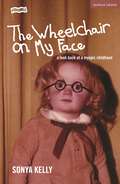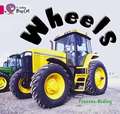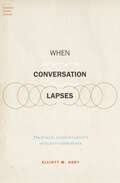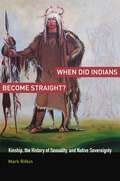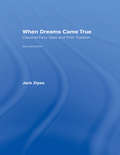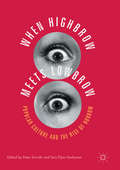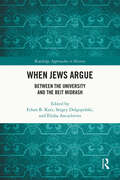- Table View
- List View
The Wheel of Autonomy: Rhetoric and Ethnicity in the Omo Valley (Integration and Conflict Studies #18)
by Felix GirkeHow do the Kara, a small population residing on the eastern bank of the Omo River in southern Ethiopia, manage to be neither annexed nor exterminated by any of the larger groups that surround them? Through the theoretical lens of rhetoric, this book offers an interactionalist analysis of how the Kara negotiate ethnic and non-ethnic differences among themselves, the relations with their various neighbors, and eventually their integration in the Ethiopian state. The model of the “Wheel of Autonomy” captures the interplay of distinction, agency and autonomy that drives these dynamics and offers an innovative perspective on social relations.
The Wheel of Fire: Interpretations Of Shakespearean Tragedy (Routledge Classics)
by G. Wilson KnightOriginally published in 1930, this classic of modern Shakespeare criticism proves both enlightening and innovative. Standing head and shoulders above all other Shakespearean interpretations, Wheel of Fire is the masterwork of the brilliant English scholar G. Wilson Knight. Founding a new and influential school of Shakespearean criticism, Wheel of Fire was Knight's first venture in the field - his writing sparkles with insight and wit, and his analyses are key to contemporary understandings of Shakespeare..
The Wheel of Fire (Routledge Classics)
by G. Wilson KnightOriginally published in 1930, this classic of modern Shakespeare criticism proves both enlightening and innovative. Standing head and shoulders above all other Shakespearean interpretations, Wheel of Fire is the masterwork of the brilliant English scholar G. Wilson Knight. Founding a new and influential school of Shakespearean criticism, Wheel of Fire was Knight's first venture in the field - his writing sparkles with insight and wit, and his analyses are key to contemporary understandings of Shakespeare..
The Wheel of Fire (Routledge Classics)
by G. Wilson KnightOriginally published in 1930, this classic of modern Shakespeare criticism proves both enlightening and innovative. Standing head and shoulders above all other Shakespearean interpretations, this is the masterwork of the brilliant English scholar, G. Wilson Knight. Founding a new and influential school of Shakespearean criticism, Wheel of Fire was Knight's first venture in the field - his writing sparkles with insight and wit, and his analyses are key to contemporary understandings of Shakespeare.
The Wheel of Fire: Interpretations Of Shakespearean Tragedy (Routledge Classics)
by G. Wilson KnightOriginally published in 1930, this classic of modern Shakespeare criticism proves both enlightening and innovative. Standing head and shoulders above all other Shakespearean interpretations, this is the masterwork of the brilliant English scholar, G. Wilson Knight. Founding a new and influential school of Shakespearean criticism, Wheel of Fire was Knight's first venture in the field - his writing sparkles with insight and wit, and his analyses are key to contemporary understandings of Shakespeare.
The Wheelchair on My Face (Modern Plays)
by Sonya Kelly'I got my first pair of glasses when I was seven.A nurse came to the school and tested everyone's eyes. And so it was discovered why I'd thrown bread to the floating crisp packets in our local pond and walked into lamp posts and said, 'excuse me'. Until that day the world was a swirl of moving coloured blobs. I thought it was the same for everyone.How wrong I was.'Part memoir, part theatre and part standup comedy this delightful story of a myopic seven year old is brought to you by actor, comedian and playwright Sonya Kelly. Sonya tells her story about growing up with poor vision that went undiagnosed until she was seven years old. Combining several forms of theatre, this delightful story shows us how we can better the world even if we cannot see the world.Winner: Scotsman Fringe First Award 2012Critic's Pick, New York Times
The Wheelchair on My Face (Modern Plays)
by Sonya Kelly'I got my first pair of glasses when I was seven.A nurse came to the school and tested everyone's eyes. And so it was discovered why I'd thrown bread to the floating crisp packets in our local pond and walked into lamp posts and said, 'excuse me'. Until that day the world was a swirl of moving coloured blobs. I thought it was the same for everyone.How wrong I was.'Part memoir, part theatre and part standup comedy this delightful story of a myopic seven year old is brought to you by actor, comedian and playwright Sonya Kelly. Sonya tells her story about growing up with poor vision that went undiagnosed until she was seven years old. Combining several forms of theatre, this delightful story shows us how we can better the world even if we cannot see the world.Winner: Scotsman Fringe First Award 2012Critic's Pick, New York Times
Wheels: Band 01b/Pink B (PDF)
by Frances Ridley Cliff Moon Collins Big CatSome wheels are big and some wheels are small. This exciting book is full of photos of all kinds of wheels: big and small, fat and thin, fast and slow, from skateboards to tractors, that children are sure to be curious about.
When Art Makes News: Writing Culture and Identity in Imperial Russia (NIU Series in Slavic, East European, and Eurasian Studies)
by Katia DianinaFrom the time the word kul'tura entered the Russian language in the early nineteenth century, Russian arts and letters have thrived on controversy. At any given time several versions of culture have coexisted in the Russian public sphere. The question of what makes something or someone distinctly Russian was at the core of cultural debates in nineteenth-century Russia and continues to preoccupy Russian society to the present day.When Art Makes News examines the development of a public discourse on national self-representation in nineteenth-century Russia, as it was styled by the visual arts and popular journalism. Katia Dianina tells the story of the missing link between high art and public culture, revealing that art became the talk of the nation in the second half of the nineteenth century in the pages of mass-circulation press.At the heart of Dianina's study is a paradox: how did culture become the national idea in a country where few were educated enough to appreciate it? Dianina questions the traditional assumptions that culture in tsarist Russia was built primarily from the top down and classical literature alone was responsible for imagining the national community. When Art Makes News will appeal to all those interested in Russian culture, as well as scholars and students in museum and exhibition studies.
When Aseneth Met Joseph: A Late Antique Tale of the Biblical Patriarch and His Egyptian Wife, Reconsidered
by Ross Shepard KraemerThis is the study of an anonymous ancient work, usually called Joseph and Aseneth, which narrates the transformation of the daughter of an Egyptian priest into an acceptable spouse for the biblical Joseph, whose marriage to Aseneth is given brief notice in Genesis. Kraemer takes issue with the scholarly consensus that the tale is a Jewish conversion story composed no later than the early second century C.E. Instead, she dates it to the third or fourth century C.E., and argues that, although no definitive answer is presently possible, it may well be a Christian account. This critique also raises larger issues about the dating and identification of many similar writings, known as pseudepigrapha. Kraemer reads its account of Aseneth's interactions with an angelic double of Joseph in the context of ancient accounts of encounters with powerful divine beings, including the sun god Helios, and of Neoplatonic ideas about the fate of souls. When Aseneth Met Joseph demonstrates the centrality of ideas about gender in the representation of Aseneth and, by extension, offers implications for broader concerns about gender in Late Antiquity.
When Conversation Lapses: The Public Accountability of Silent Copresence (Foundations of Human Interaction)
by Elliott M. HoeySilence takes on meaning based on the contexts of its occurrence. This is especially true in social interactions: consider the difference between silence after "lemme think," and silence after "will you marry me?" This book examines a particular form of silence, the conversational lapse. These regularly appear in conversations when all interactants pass up the opportunity to speak, and are moments when talk seems to falter or give way to matters extraneous to the conversation. What are these silences for the participants who, by virtue of not speaking, allowed them to develop? Elliott M. Hoey here offers the first in-depth analysis of lapses in conversation. Using methods from Conversation Analysis, the author explores hundreds of lapses in naturally occurring social occasions with each chapter focusing on a different aspect of how participants produce and locate order in lapses. Particular emphasis is given to how lapses emerge, what people do during the silence, and how they restart conversation afterwards. This research uncovers participants' methods for organizing lapses in their everyday affairs such that those silences are rendered as understandable periods of non-talk. By articulating participants' understandings of when and where talk is relevant, necessary, or appropriate, the research brings into focus the borderlines between talk-in-interaction and other realms of social life. This book shows lapses to be a particular and fascinating kind of silence with unique relevancies for the social situations of which they are a part.
When Conversation Lapses: The Public Accountability of Silent Copresence (Foundations of Human Interaction)
by Elliott M. HoeySilence takes on meaning based on the contexts of its occurrence. This is especially true in social interactions: consider the difference between silence after "lemme think," and silence after "will you marry me?" This book examines a particular form of silence, the conversational lapse. These regularly appear in conversations when all interactants pass up the opportunity to speak, and are moments when talk seems to falter or give way to matters extraneous to the conversation. What are these silences for the participants who, by virtue of not speaking, allowed them to develop? Elliott M. Hoey here offers the first in-depth analysis of lapses in conversation. Using methods from Conversation Analysis, the author explores hundreds of lapses in naturally occurring social occasions with each chapter focusing on a different aspect of how participants produce and locate order in lapses. Particular emphasis is given to how lapses emerge, what people do during the silence, and how they restart conversation afterwards. This research uncovers participants' methods for organizing lapses in their everyday affairs such that those silences are rendered as understandable periods of non-talk. By articulating participants' understandings of when and where talk is relevant, necessary, or appropriate, the research brings into focus the borderlines between talk-in-interaction and other realms of social life. This book shows lapses to be a particular and fascinating kind of silence with unique relevancies for the social situations of which they are a part.
When Did Indians Become Straight?: Kinship, the History of Sexuality, and Native Sovereignty
by Mark RifkinWhen Did Indians Become Straight? explores the complex relationship between contested U.S. notions of normality and shifting forms of Native American governance and self-representation. Examining a wide range of texts (including captivity narratives, fiction, government documents, and anthropological tracts), Mark Rifkin offers a cultural and literary history of the ways Native peoples have been inserted into Euramerican discourses of sexuality and how Native intellectuals have sought to reaffirm their peoples' sovereignty and self-determination.
When Did Indians Become Straight?: Kinship, the History of Sexuality, and Native Sovereignty
by Mark RifkinWhen Did Indians Become Straight? explores the complex relationship between contested U.S. notions of normality and shifting forms of Native American governance and self-representation. Examining a wide range of texts (including captivity narratives, fiction, government documents, and anthropological tracts), Mark Rifkin offers a cultural and literary history of the ways Native peoples have been inserted into Euramerican discourses of sexuality and how Native intellectuals have sought to reaffirm their peoples' sovereignty and self-determination.
When Dreams Came True: Classical Fairy Tales and Their Tradition
by Jack ZipesFor centuries fairy tales have been a powerful mode of passing cultural values onto our children, and for many these stories delight and haunt us from cradle to grave. But how have these stories become so powerful and why? In When Dreams Came True, Jack Zipes explains the social life of the fairy tale, from the sixteenth century on into the twenty-first. Whether exploring Charles Perrault or the Brothers Grimm, Hans Christian Andersen or The Thousand and One Nights, The Happy Prince or Pinocchio, L. Frank Baum or Hermann Hesse, Zipes shows how the authors of our beloved fairy tales used the genre to articulate personal desires, political views, and aesthetic preferences within particular social contexts. Above all, he demonstrates the role that the fairy tale has assumed in the civilizing process—the way it imparts values, norms, and aesthetic taste to children and adults. This second edition of one of Jack Zipes’s best-loved books includes a new preface and two new chapters on J.M. Barrie’s Peter Pan and E.T.A. Hoffman’s The Nutcracker and the Mouse King.
When Dreams Came True: Classical Fairy Tales and Their Tradition
by Jack ZipesFor centuries fairy tales have been a powerful mode of passing cultural values onto our children, and for many these stories delight and haunt us from cradle to grave. But how have these stories become so powerful and why? In When Dreams Came True, Jack Zipes explains the social life of the fairy tale, from the sixteenth century on into the twenty-first. Whether exploring Charles Perrault or the Brothers Grimm, Hans Christian Andersen or The Thousand and One Nights, The Happy Prince or Pinocchio, L. Frank Baum or Hermann Hesse, Zipes shows how the authors of our beloved fairy tales used the genre to articulate personal desires, political views, and aesthetic preferences within particular social contexts. Above all, he demonstrates the role that the fairy tale has assumed in the civilizing process—the way it imparts values, norms, and aesthetic taste to children and adults. This second edition of one of Jack Zipes’s best-loved books includes a new preface and two new chapters on J.M. Barrie’s Peter Pan and E.T.A. Hoffman’s The Nutcracker and the Mouse King.
When Dreams Came True: Classical Fairy Tales and Their Tradition
by Jack ZipesFirst Published in 1999. Routledge is an imprint of Taylor & Francis, an informa company.
When Dreams Came True: Classical Fairy Tales and Their Tradition
by Jack ZipesFirst Published in 1999. Routledge is an imprint of Taylor & Francis, an informa company.
When Fiction Feels Real: Representation and the Reading Mind
by Elaine AuyoungWhy do readers claim that fictional worlds feel real? How can certain literary characters seem capable of leading lives of their own, outside the stories in which they appear? What makes the experience of reading a novel uniquely pleasurable and what do readers lose when this experience comes to an end? Since their first publication, nineteenth-century realist novels like Pride and Prejudice and Anna Karenina have inspired readers to describe literary experience as gaining access to vibrant fictional worlds and becoming friends with fictional characters. While this effect continues to be central to the experience of reading realist fiction and later works in this tradition, the capacity for novels to evoke persons and places in a reader's mind has often been taken for granted and even dismissed as a naive phenomenon unworthy of critical attention. When Fiction Feels Real provides literary studies with new tools for thinking about the phenomenology of reading by bringing narrative techniques into conversation with psychological research on reading and cognition. Through close readings of classic novels by Jane Austen, Charles Dickens, George Eliot, and Leo Tolstoy, and the elegies of Thomas Hardy, Elaine Auyoung reveals what nineteenth-century writers know about how reading works. Building on well-established research on the mind, Auyoung exposes the underpinnings of the seemingly impossible achievement of realist fiction, introducing new perspectives on narrative theory, mimesis, and fictionality. When Fiction Feels Real changes the way we think about literary language, realist aesthetics, and the reading process, opening up a new field of inquiry centered on the relationship between fictional representation and comprehension.
WHEN FICTION FEELS REAL C: Representation and the Reading Mind
by Elaine AuyoungWhy do readers claim that fictional worlds feel real? How can certain literary characters seem capable of leading lives of their own, outside the stories in which they appear? What makes the experience of reading a novel uniquely pleasurable and what do readers lose when this experience comes to an end? Since their first publication, nineteenth-century realist novels like Pride and Prejudice and Anna Karenina have inspired readers to describe literary experience as gaining access to vibrant fictional worlds and becoming friends with fictional characters. While this effect continues to be central to the experience of reading realist fiction and later works in this tradition, the capacity for novels to evoke persons and places in a reader's mind has often been taken for granted and even dismissed as a naive phenomenon unworthy of critical attention. When Fiction Feels Real provides literary studies with new tools for thinking about the phenomenology of reading by bringing narrative techniques into conversation with psychological research on reading and cognition. Through close readings of classic novels by Jane Austen, Charles Dickens, George Eliot, and Leo Tolstoy, and the elegies of Thomas Hardy, Elaine Auyoung reveals what nineteenth-century writers know about how reading works. Building on well-established research on the mind, Auyoung exposes the underpinnings of the seemingly impossible achievement of realist fiction, introducing new perspectives on narrative theory, mimesis, and fictionality. When Fiction Feels Real changes the way we think about literary language, realist aesthetics, and the reading process, opening up a new field of inquiry centered on the relationship between fictional representation and comprehension.
When Highbrow Meets Lowbrow: Popular Culture and the Rise of Nobrow
by Peter Swirski Tero Eljas VanhanenThis book examines nobrow, a cultural formation that intertwines art and entertainment into an identifiable creative force. In our eclectic and culturally turbocharged world, the binary of highbrow vs. lowbrow is incapable of doing justice to the complexity and artistry of cultural production. Until now, the historical power, aesthetic complexity, and social significance of nobrow “artertainment” have escaped analysis. This book rectifies this oversight. Smart, funny, and iconoclastic, it scrutinizes the many faces of nobrow, throwing surprising light on the hazards and rewards of traffic between high entertainment and genre art.
When I Fall ... If I Fall (Modern Plays)
by Claire DowieI don't understand it. I've still got muscles, tendons, sinews, whatnots – nothing's changed skeleton wise, body wise. It's still all intact.Yet it doesn't work. It won't move itself.Leaping barriers of age, sexuality and gender, Gloria prepares to dance the Can Can one last time. Written and performed by the pioneering Claire Dowie, When I Fall If I Fall tells Gloria's story, a story about growing up feeling different and not fitting in... With this new work, Dowie continues her ground-breaking subversion of gender expectations and stereotypes.This edition was published to coincide with the world premiere at the Edinburgh Fringe Festival, in August 2019.
When I Fall ... If I Fall (Modern Plays)
by Claire DowieI don't understand it. I've still got muscles, tendons, sinews, whatnots – nothing's changed skeleton wise, body wise. It's still all intact.Yet it doesn't work. It won't move itself.Leaping barriers of age, sexuality and gender, Gloria prepares to dance the Can Can one last time. Written and performed by the pioneering Claire Dowie, When I Fall If I Fall tells Gloria's story, a story about growing up feeling different and not fitting in... With this new work, Dowie continues her ground-breaking subversion of gender expectations and stereotypes.This edition was published to coincide with the world premiere at the Edinburgh Fringe Festival, in August 2019.
When Jews Argue: Between the University and the Beit Midrash (Routledge Approaches to History)
by Ethan B. Katz Sergey Dolgopolski Elisha AncselovitsThis book re-thinks the relationship between the world of the traditional Jewish study hall (the Beit Midrash) and the academy: Can these two institutions overcome their vast differences? Should they attempt to do so? If not, what could two methods of study seen as diametrically opposed possibly learn from one another? How might they help each other reconceive their interrelationship, themselves, and the broader study of Jews and Judaism? This book begins with three distinct approaches to these challenges. The chapters then follow the approaches through an interdisciplinary series of pioneering case studies that reassess a range of topics including religion and pluralism in Jewish education; pain, sexual consent, and ethics in the Talmud; the place of reason and devotion among Jewish thinkers as diverse as Moses Mendelssohn, Jacob Taubes, Sarah Schenirer, Ibn Chiquitilla, Yair Ḥayim Bacharach, and the Rav Shagar; and Jewish law as a response to the post-Holocaust landscape. The authors are scholars of rabbinics, history, linguistics, philosophy, law, and education, many of whom also have traditional religious training or ordination. The result is a book designed for learned scholars, non-specialists, and students of varying backgrounds, and one that is sure to spark debate in the university, the Beit Midrash, and far beyond.
When Jews Argue: Between the University and the Beit Midrash (Routledge Approaches to History)
This book re-thinks the relationship between the world of the traditional Jewish study hall (the Beit Midrash) and the academy: Can these two institutions overcome their vast differences? Should they attempt to do so? If not, what could two methods of study seen as diametrically opposed possibly learn from one another? How might they help each other reconceive their interrelationship, themselves, and the broader study of Jews and Judaism? This book begins with three distinct approaches to these challenges. The chapters then follow the approaches through an interdisciplinary series of pioneering case studies that reassess a range of topics including religion and pluralism in Jewish education; pain, sexual consent, and ethics in the Talmud; the place of reason and devotion among Jewish thinkers as diverse as Moses Mendelssohn, Jacob Taubes, Sarah Schenirer, Ibn Chiquitilla, Yair Ḥayim Bacharach, and the Rav Shagar; and Jewish law as a response to the post-Holocaust landscape. The authors are scholars of rabbinics, history, linguistics, philosophy, law, and education, many of whom also have traditional religious training or ordination. The result is a book designed for learned scholars, non-specialists, and students of varying backgrounds, and one that is sure to spark debate in the university, the Beit Midrash, and far beyond.



